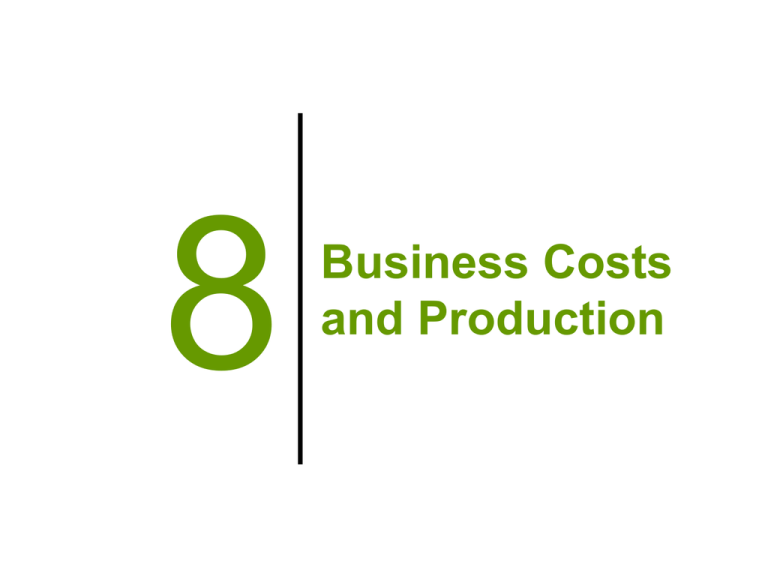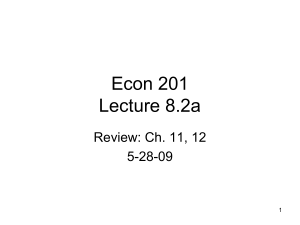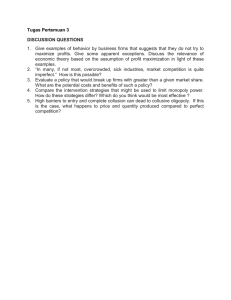8 Business Costs and Production
advertisement

8 Business Costs and Production Practice What You Know Bob runs a small family restaurant. How would you describe the monthly rent he pays on the building? A. B. C. D. Explicit cost, variable cost Explicit cost, fixed cost Implicit cost, variable cost Implicit cost, fixed cost Practice What You Know Which of the following is an example of an implicit cost? A. B. C. D. Wages paid to employees Cost of food delivery The opportunity cost of the owner’s time Monthly insurance premiums Practice What You Know Suppose the wage rate that a company pays its workers increases. In terms of the cost equations, which of the following is true? A. B. C. D. TC will increase, but ATC will decrease TVC will increase, but AVC will decrease The MC curve will become hill-shaped The TFC and AFC will not change Practice What You Know Total output with seven workers is Q = 70. Total output with eight workers is Q = 82. What is the marginal product of the eighth worker? A. B. C. D. 12 10 82 8 9 Firms in a Competitive Market Practice What You Know Steve runs a competitive sandwich shop. Right now, he is producing output at a level where MR > MC. To increase his profits, Steve should A. B. C. D. Try to use more capital in his production Try to use more labor in his production Produce less output Produce more output Practice What You Know If a competitive industry is making positive economic profits, what will eventually happen in this industry? A. B. C. D. The market supply will shift to the left The market supply will shift to the right The market demand will shift to the left The market demand will shift to the right Practice What You Know Suppose a competitive firm is faced with a price in the short run that is below ATC but above AVC. In the short run, this firm should A. B. C. D. Shut down Exit the industry Raise the price of the good Produce at the output level where MR = MC Practice What You Know What do you suppose is one of the main reasons that competitive firms all earn zero economic profits in the long run? A. B. C. D. Each firm has a lot of market power Firms all want to earn zero profits Free entry and exit in the industry The cost curves are U-shaped Practice What You Know A competitive firm will shut down and produce output level Q = 0 if A. B. C. D. Price < min (ATC) min (AVC) < Price < min (ATC) Price < min (AVC) P = MR 10 Understanding Monopoly Practice What You Know Which of the following firms will most likely be a natural monopoly? A. B. C. D. A grocery store A cable TV company A gas station A barbershop Practice What You Know Which of the following most accurately describes a patent? A. B. C. D. An incentive to innovate A profit-sharing mechanism A redistribution of wealth An original invention Practice What You Know What is true for a profit-maximizing monopoly? A. B. C. D. P = MR = MC P = MR > MC P > MR = MC P > MR > MC Practice What You Know What is the reason for monopoly deadweight loss (relative to perfect competition)? A. The monopolist faces a downward sloping demand curve B. People boycott monopolies more often C. The monopolist sells less output at a higher price D. The monopolist has no competitors Practice What You Know A monopolist will have negative profits and exit the industry in the long run if: A. B. C. D. A new competitor enters the industry Demand becomes more elastic Price < ATC A monopolist never has negative profits 11 Price Discrimination Practice What You Know Which of the following goods or services is most likely to be sold successfully by a firm at different prices? A. B. C. D. Economics textbooks Haircuts Candy bars University apparel Practice What You Know A general rule for price discriminating with two consumers groups is to charge a ______ price to the inelastic group and to charge a ______ price to the elastic group. A. B. C. D. high; low low; high positive; negative negative; positive Practice What You Know What market and pricing structure has the least amount of consumer surplus? A. Perfect competition B. Pure monopoly (single price) C. A price discriminating monopoly that charges two different prices D. A monopolist that engages in perfect price discrimination Practice What You Know Why might one consumer group (A) have a more elastic demand (and be more price sensitive) than another group (B) of consumers? A. Group (A) may have less income B. Group (A) may have lower tastes and preferences for the good C. Both of the above could be true D. None of the above 12 Monopolistic Competition and Advertising Practice What You Know Which of the following is true about monopolistic competition? A. It results in higher prices than monopoly B. It results in higher prices than perfect competition C. It results in lower quantity than monopoly D. It is more economically efficient than perfect competition Practice What You Know Which of the following industries fits most closely with the model of monopolistic competition? A. Automobile production B. Farming C. Diamond mining D. Fast-food restaurants Practice What You Know What is true about the long run equilibrium for firms in a monopolistically competitive industry? A. MR < MC, P < min(ATC) B. P = MR = MC = min(ATC) C. P = ATC, P > MC, P > min(ATC) D. P > ATC, P = MC Practice What You Know Which of the following is true about product differentiation? A. More differentiation means products are more substitutable for each other B. More differentiation leads to greater differences in price C. More differentiation leads to converging prices D. Differentiation lowers firm profits 13 Oligopoly and Strategic Behavior Practice What You Know Which of the following is most likely to become an oligopoly industry? A. An industry without entry barriers B. An industry where economies of scale are very small C. An industry with sizeable network effects D. An industry with hundreds of competitors Practice What You Know Which of the following is true about oligopoly? A. Oligopolies are illegal in the United States B. All oligopoly industries will try to collude C. Oligopoly industries generally have a high concentration ratio D. Firms in an oligopoly act independently from other firms in the oligopoly Practice What You Know Why do cartel deals tend not to last? A. Each firm in the cartel has a dominant strategy to be uncooperative and defect from the cartel agreement B. Cartel profits are lower than competitive profits C. Cartels create more competition D. Firms know that cartels are often illegal so they break the deal to escape Practice What You Know What is an example of a good with a positive network effect? A. An online multiplayer game B. A fast-food burger C. A dry-cleaning service D. A cable TV subscription Practice What You Know How can a pure strategy Nash equilibrium be accurately described? A. It is always the overall best outcome B. It’s an outcome in which neither player wants to change strategies C. It can only be reached by collusion D. One exists in all games





